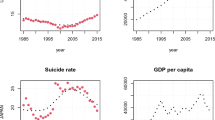Abstract
Hidden Markov models (HMMs) are a popular approach for modeling sequential data, typically based on the assumption of a first-order Markov chain. In other words, only one-step back dependencies are modeled which is a rather unrealistic assumption in most applications. In this paper, we propose a method for postulating HMMs with approximately infinitely-long time-dependencies. Our approach considers the whole history of model states in the postulated dependencies, by making use of a recently proposed nonparametric Bayesian method for modeling label sequences with infinitely-long time dependencies, namely the sequence memoizer. We manage to derive training and inference algorithms for our model with computational costs identical to simple first-order HMMs, despite its entailed infinitely-long time-dependencies, by employing a mean-field-like approximation. The efficacy of our proposed model is experimentally demonstrated.
Access this chapter
Tax calculation will be finalised at checkout
Purchases are for personal use only
Preview
Unable to display preview. Download preview PDF.
Similar content being viewed by others
References
Cappé, O., Moulines, E., Rydén, T.: Inference in Hidden Markov Models. Springer, New York (2005)
Mari, J., Fohr, D., Junqua, J.: A second-order HMM for high-performance word and phoneme-based continuous speech recognition. In: Proc. of the IEEE Int. Conf. on Acoustics, Speech and Signal Processing, pp. 435–438 (1996)
Mari, J.F., Haton, J.P., Kriouile, A.: Automatic word recognition based on second-order hidden Markov models. IEEE Trans. Speech Audio Process. 5, 22–25 (1997)
Aycard, O., Mari, J.F., Washington, R.: Learning to automatically detect features for mobile robots using second-order HMMs. Int. J. Adv. Robotic Syst. 1, 231–245 (2004)
Engelbrecht, H., du Preez, J.: Efficient backward decoding of high-order hidden markov models. Pattern Recognition 43, 99–112 (2010)
Wood, F., Gasthaus, J., Archambeau, C., James, L., Teh, Y.W.: The sequence memoizer. Communications of the ACM 54, 91–98 (2011)
Celeux, G., Forbes, F., Peyrard, N.: EM procedures using mean field-like approximations for Markov model-based image segmentation. Patt. Recogn. 36, 131–144 (2003)
Zhang, J.: The mean field theory in EM procedures for Markov random fields. IEEE Transactions on Image Processing 2, 27–40 (1993)
Pitman, J., Yor, M.: The two-parameter Poisson-Dirichlet distribution derived from a stable subordinator. Annals of Probability 25, 855–900 (1997)
Teh, Y.W.: A hierarchical Bayesian language model based on Pitman-Yor processes. In: Proc. Assoc. for Comp. Linguistics, pp. 985–992 (2006)
Wood, F., Archambeau, C., Gasthaus, J., James, L.F., Teh, Y.: A stochastic memoizer for sequence data. In: Proc. Int. Conference on Machine Learning (ICML) (2009)
Chandler, D.: Introduction to Modern Statistical Mechanics. Oxford Univ. Press (1987)
Geiger, D., Girosi, F.: Parallel and deterministic algorithms from MRFs: surface reconstruction. IEEE Trans. Pattern Anal. Mach. Intell. 13, 401–412 (1991)
Zerubia, J., Chellappa, R.: Mean field approximation using compound Gauss-Markov random field for edge detection and image restoration. In: Proc. ICASSP, pp. 2193–2196 (1990)
Jaakkola, T., Jordan, M.: Improving the mean field approximation via the use of mixture distributions. In: Jordan, M. (ed.) Learning in Graphical Models, pp. 163–173. Kluwer (1998)
Hofmann, T., Buhmann, J.: Pairwise data clustering by deterministic annealing. IEEE Trans. Pattern Anal. Mach. Intell. 19, 1–14 (1997)
Rabiner, L.: A tutorial on hidden Markov models and selected applications in speech recognition. Proceedings of the IEEE 77, 245–255 (1989)
Rabiner, L.: A tutorial on hidden Markov models and selected applications in speech recognition. Proceedings of the IEEE 77, 245–255 (1989)
McLachlan, G., Peel, D.: Finite Mixture Models. Wiley Ser. Probability and Statistics (2000)
Chatzis, S.P., Varvarigou, T.A.: A fuzzy clustering approach toward hidden Markov random field models for enhanced spatially constrained image segmentation. IEEE Trans. on Fuzzy Systems 16, 1351–1361 (2008)
Chatzis, S.P., Tsechpenakis, G.: The infinite hidden Markov random field model. IEEE Transactions on Neural Networks 21, 1004–1014 (2010)
Voulodimos, A., et al.: A threefold dataset for activity and workflow recognition in complex industrial environments. IEEE Multimedia 19, 42–52 (2012)
Ni, B., Wang, G., Moulin, P.: RGBD-HuDaAct: A color-depth video database for human daily activity recognition. In: ICCV Workshops, pp. 1147–1153 (2011)
Kudo, M., Toyama, J., Shimbo, M.: Multidimensional curve classification using passing through regions. Pattern Recogn. Lett. 20, 1103–1111 (1999)
Jaeger, H., Maass, W., Principe, J.: Special issue on echo state networks and liquid state machines. Neural Networks 20, 287 (2007)
Tsochantaridis, I., Joachims, T., Hofmann, T., Altun, Y.: Large margin methods for structured and interdependent output variables. J. Mach. Learn. Res. 6, 1453–1484 (2005)
McCallum, A., Freitag, D., Pereira, F.C.N.: Maximum entropy markov models for information extraction and segmentation. In: Proc. of the Int. Conf. on Mach. Learning, ICML 2000, pp. 591–598 (2000)
Sha, F., Saul, L.K.: Large margin hidden markov models for automatic speech recognition. In: Advances in Neural Information Processing Systems 19, pp. 1249–1256. MIT Press (2007)
Author information
Authors and Affiliations
Editor information
Editors and Affiliations
Rights and permissions
Copyright information
© 2014 Springer International Publishing Switzerland
About this paper
Cite this paper
Chatzis, S.P., Kosmopoulos, D.I., Papadourakis, G.M. (2014). A Nonstationary Hidden Markov Model with Approximately Infinitely-Long Time-Dependencies. In: Bebis, G., et al. Advances in Visual Computing. ISVC 2014. Lecture Notes in Computer Science, vol 8888. Springer, Cham. https://doi.org/10.1007/978-3-319-14364-4_6
Download citation
DOI: https://doi.org/10.1007/978-3-319-14364-4_6
Publisher Name: Springer, Cham
Print ISBN: 978-3-319-14363-7
Online ISBN: 978-3-319-14364-4
eBook Packages: Computer ScienceComputer Science (R0)




